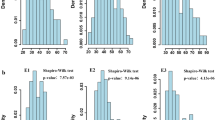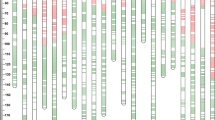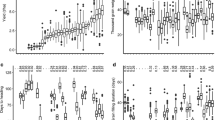Abstract
Traits related to spike morphology (SM), including grain density (GD), spike length (SL) and awn length (AL), are of central importance in cereal improvement. A recent study based on a two-row landrace of barley, TX9425, detected QTL controlling all of the three traits in a similar region on the long arm of chromosome 3H. To further characterize this chromosomal region, 12 pairs of near isogenic lines (NILs) for GD were generated from two populations between TX9425 and two different commercial cultivars. A population consisting of 1,028 lines segregating primarily for the target region was also developed using materials generated during the production of these NILs. Results from the analysis of the NILs and the NIL-derived population showed that these three traits were likely controlled by a single-locus which was mapped to a 2.84 cM interval between two SSR markers, GBM1495 and HVM33. Across the 12 pairs of NILs, the presence of the 3HL locus increased GD by 53.4 %, reduced SL and AL by 38.8 % and 62.7 %, respectively. In the NIL-derived population, the presence of the 3HL locus increased GD by 64.6 %, reduced SL and AL by 33.7 % and 62.6 %, respectively. An interesting question arising from this research is why some loci such as the one reported here affect several SM-related traits while others appear to affect one of these traits only. The NILs and the NIL-derived population generated in this study will help answer such questions by providing the germplasm to enable cloning and comparative analysis of the genes responsible for these SM-related traits.




Similar content being viewed by others
References
Baghizadeh A, Taleei AR, Naghavi MR (2007) QTL analysis for some agronomic traits in barley (Hordum vulgare L). Int J Agr Bio 9:372–374
Duncan DB (1955) Multiple range and multiple F tests. Biometrics 11:1–42
Grundbacher FJ (1963) The physiological function of the cereal awn. Bot Rev 29:366–381
Hoogendoorn J, Rickson JM, Gale MD (1990) Differences in leaf and stem anatomy related to plant height of all and dwarf wheat (Triticum aestivum L.). J Plant Physiol 136:72–77
Hori K, Kobayashi T, Shimizu A, Sato K, Takeda K, Kawasaki S (2003) Efficient construction of a high-density linkage map and its application to QTL analysis in barley. Theor Appl Genet 107:806–813
Kjack JL, Witters RE (1974) Physiological activity of awns in isolines of Atlas barley. Crop Sci 14:243–248
Kjær B, Jenson J, Giese H (1995) Quantitative trait loci for heading date and straw characters in barley. Genome 38:1098–1104
Li HB, Zhou MX, Liu CJ (2009) A major QTL conferring crown rot resistance in barley and its association with plant height. Theor Appl Genet 118:903–910
Liu YX, Yang XM, Ma J, Wei YM, Zheng YL, Ma HX, Yao JB, Manners JM, Liu CJ (2010) Plant height affects crown rot severity in wheat (Triticum aestivum L.). Phytopathology 100:1276–1281
Ma J, Yan GJ, Liu CJ (2012) Development of near-isogenic lines for a major QTL on 3BL conferring Fusarium crown rot resistance in hexaploid wheat. Euphytica 183:147–152
Miedaner T, Voss HH (2008) Effect of dwarfing Rht genes on Fusarium head blight resistance in two sets of near-isogenic lines of wheat and check cultivars. Crop Sci 48:2115–2122
Paterson AH, Lander ES, Hewitt JD, Peterson S, Linoln SE, Tanksley SD (1988) Resolution of quantitative traits into Mendelian factors by using a complete linkage map of restriction fragment length polymorphisms. Nature 335:721–736
Sameri M, Takeda K, Komatsuda T (2006) Quantitative trai loci controlling agronomic traits in recombinant inbred lines from a cross between oriental- and occidental-type barley cultivars. Breed Sci 56:243–252
Shahinnia F, Druka A, Franckowiak J, Morgante M, Waugh R, Stein N (2012) High resolution mapping of dense spike-ar (asp.ar) to the genetic centromere of barley chromosome 7H. Theor Appl Genet 124:373–384
Takahashi R (1987) Genetic features of East Asian barleys. In:Yasuda S and Konishi T (eds.) Barley Genetics V. Maruzen, Okayama, pp 7-20
Taketa Y, You T, Sakurai Y, Miyake S, Ichii M (2011) Molecular mapping of the short awn 2 (lks2) and dense spike 1 (dsp1) genes on barley chromosome 7H. Breed Sci 61:80–85
Tuinstra MR, Ejeta G, Goldsbrough PB (1997) Heterogeneous inbred family (HIF) analysis: a method for developing near-isogenic lines that differ at quantitative trait loci. Theor Appl Genet 95:1005–1011
Van Ooijen JW (2006) JoinMap® 4, Software for the calculation of genetic linkage maps in experimental populations. Kyazma BV, Wageningen
Wang J, Yang J, McNeil DL, Zhou M (2010) Identification and molecular mapping of a dwarfing gene in barley (Hordeum vulgare L.) and its correlation with other agronomic traits. Euphytica 175:331–342
Yan W, Li HB, Cai SB, Ma HX, Rebetzke GJ, Liu CJ (2011) Effects of plant height vary with type I and type II resistance of Fusarium head blight in wheat (Triticum aestivum L.). Plant Pathol 60:506–512
Youssefian S, Kirby EJM, Gale MD (1992) Pleiotropic effects of the GA-insensitive Rht dwarfing genes in wheat. 2. Effects on leaf, stem, ear and floret growth. Field Crop Res 28:191–210
Zhang J (2000) Inheritance of agronomic traits from the Chinese barley dwarfing gene donors ‘Xiaoshan Lixiahuang’ and ‘Cangzhou Luodama’. Plant Breed 119:523–524
Acknowledgments
GDC acknowledges the China Scholarship Council for funding his visit to CSIRO Plant Industry. The authors are grateful to Drs Eric Huttner and Andrzej Kilian at the Diversity Arrays Technology Pty Ltd for providing sequences of the DArT markers.
Author information
Authors and Affiliations
Corresponding authors
Additional information
Communicated by Y. Xu.
G. D. Chen and H. B. Li contributed equally to this work.
Electronic supplementary material
Below is the link to the electronic supplementary material.
Rights and permissions
About this article
Cite this article
Chen, G.D., Li, H.B., Zheng, Z. et al. Characterization of a QTL affecting spike morphology on the long arm of chromosome 3H in barley (Hordeum vulgare L.) based on near isogenic lines and a NIL-derived population. Theor Appl Genet 125, 1385–1392 (2012). https://doi.org/10.1007/s00122-012-1918-3
Received:
Accepted:
Published:
Issue Date:
DOI: https://doi.org/10.1007/s00122-012-1918-3




